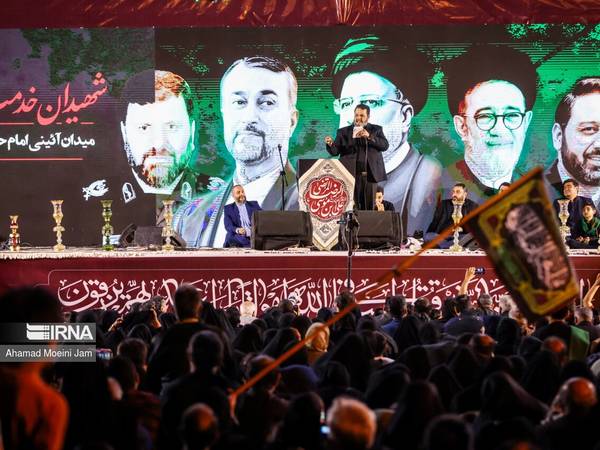Government ceremonies in Iran have been Islamized since 1979, reflecting the transformation of the state into an Islamist entity. In this process, religious icons and ceremonies replaced national symbols and rituals.
Central to these rituals is the act of mourning, as Shia Islam is a religion deeply rooted in themes of victimhood and martyrdom, with followers shedding tears for saints who, according to Shia beliefs, were all martyrs.
For this reason, during Shia mourning seasons such as Ashura and Arbaeen, the anniversaries of Shia saints' deaths, the anniversary of the Islamic Republic's founder's death, and the sudden deaths of current leading figures, the mourning industry, with the full support of governmental, state, and public institutions (including municipalities), becomes highly active. The objectives are to restore the Islamic Republic's declining legitimacy and popularity and to strengthen its social base.
This multi-billion-dollar industry is a crucial part of the regime's propaganda machine. Gone are the spontaneous and purely religious ceremonies of the pre-1979 era. Today, every national mourning ceremony is a state-sponsored program, meticulously planned and executed, from budgeting and organization to procurement and mass mobilization. The attendees of these ceremonies are not merely independent believers and mourners; officials often inflate the numbers of these engineered crowds, presenting tens or hundreds of thousands as millions to secure more funding. The core attendees are primarily public sector employees and those who benefit from the system, with a smaller portion consisting of the poor and unemployed, attracted by the promise of free meals, drinks, or pilgrimage opportunities.
The budget
There are special budget lines for government propaganda, including mourning ceremonies, in the government’s annual budgets for all ministries and organizations under the title of a 2% cultural contribution (out of the $110b annual budget for 2024). There is a direct budget of $600 million, plus the contributions from each ministry and government entity. This propaganda budget is devoted to promoting the Islamic Republic’s ideological tenets, not climate change, equal rights or similar ideals.
Apart from this, hundreds of cultural institutions which pretend to be charities, research institutes, or think tanks are involved in these propaganda activities. The government budget for religious institutions for 2024 was about 360 trillion rials ($600m), which is used to maintain the infrastructure and functions of this industry - such as hiring and taking care of personnel and facilities. We do not know exactly how much money government-owned companies and banks with a share of about 60% of the yearly budget spend in this area; they are all non-transparent. The municipalities take care of the budget for local religious groups, which are the main handlers of the ceremonies.
Khamenei’s office, which oversees several enterprises worth tens of billions of dollars, allocates some budget for religious institutions, but the specifics of these allocations have never been disclosed.
Hotel fees for travelers to attend official funerals or Arbaeen ceremonies in Iraq, thousands of buses that provide transportation services to the attendees, food, insurance, and other services presented by tents and prayer stations are all paid by government and public funds.
Organization
Three large organizations with tens of thousands of employees and budgets of tens of millions of dollars organize mourning and other religious-state ceremonies: the Islamic Propaganda Organization, the IRGC’s Basij Organization, and offices of Friday prayer imams and representatives of the Supreme Leader throughout the country. The satellite institutions that run these programs include headquarters for performing prayers, cultural centers of mosques, units for commanding good and forbidding vice, zakat offices, and numerous Sharia enforcement headquarters. Additionally, the ideological units of the Basij, IRGC, and the national army are involved. These organizations are coordinated by the Coordination Council for Islamic Propaganda.
All high-ranking officials are supposed to participate in these programs. The recruitment pool of participants is mainly neighborhood Basij bases, religious delegations, and eulogy and Qur'an groups.
Logistics
With the expansion of the mourning industry, many procurement activities have been entrusted to private sector institutions established by regime affiliates, taking over from governmental and public sectors. These institutions provide a wide range of necessary supplies, from large kitchens and rest areas for children to establishments producing tracts, banners, and advertising pamphlets. They are always ready to mobilize, much like the service sector in Hollywood, providing everything from flags, fake monuments, keffiyehs, and headbands to cardboard tombs, pickup trucks, and sound systems.
Institutions of eulogy
There is a state-sponsored institution in Iran, which is in charge of education and welfare services and social benefits for Islamist eulogists, religious DJs, and masters of ceremonies. Its mission is to propagate the culture of mourning and Shia eulogy. This institution covers tens of thousands of eulogists invited to government and public centers on dozens of occasions. Professional religious singers even provide eulogy services on special jets carrying the bodies of state leaders to their burial sites, such as Raisi's coffin being transported to Mashhad this week. In videos of Raisi’s funeral ceremonies, from Tabriz and Qom to Tehran, Birjand, and Mashhad, the voices of numerous eulogists can be heard resonating over the crowds and participants.
